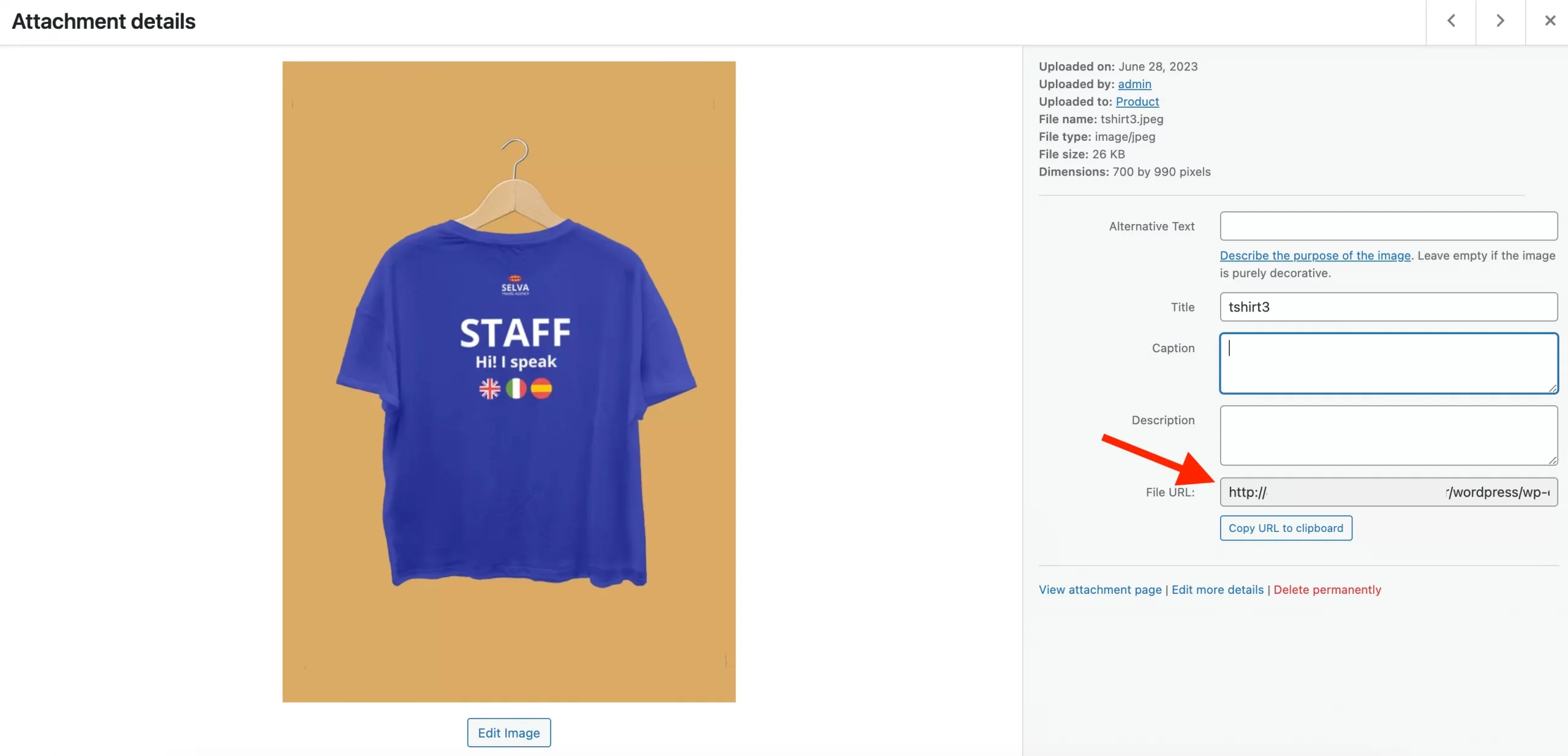WooCommerce is an open-source platform powered by WordPress that is packed with all the features needed when building your eCommerce store. If you decide to choose this platform, you might wonder how to perform WooCommerce CSV import to transfer your data to this platform seamlessly.
Fortunately, you have come to the right place. We have just provided the correct answer that you’ve been looking for. And one by one, these key points will be addressed in the article today:
- All to know about Woocommerce CSV import variable products
- Manually import data to WooCommerce using CSV files
- WooCommerce CSV import with LitExtension
No more beating around the bush. Let’s dive into it!
WooCommerce CSV formatting
Before importing products into WooCommerce using a CSV file, you must understand clearly the required format and how each column maps to product properties. But no worries; the table below will help you navigate the process with better clarity.
CSV Colume Name | Maps to product property | Example | Notes |
ID | id | 100 | Defining this will overwrite data for that ID on import. |
Type | type | simple, variation, virtual | Valid values including: simple, variable, grouped, external, variation, virtual, downloadable. Multiple types are seperated by comma. |
SKU | sku | my-sku | Auto-generated if missing. |
Name | name | name | Required |
Published | status | 1 | 1: published 0: private -1: draft |
Is featured? | featured | 1 | 1: featured 0: not featured |
Visibility in catalog | catalog_visibility | visible | Supported values: visible, catalog, search, hidden |
Short description | short_description | This is my product | |
Description | description | More information about the product | |
Date sale price start | date_on_sale_from | 2024-04-04 | Date (start of day) or leave blank. |
Date sale price ends | date_on_sale_to | 2024-08-08 | Date (end of day) or leave blank. |
Tax status | tax_status | taxable | Supported values: taxable, shipping, none |
Tax class | tax_class | standard | Can use any existing tax class. |
In stock? | stock_status | 1 | 1: In stock 0: Out of stock |
Stock | manage_stock / stock_quantity | 25 | Numeric stock level enables stock management. parent can be used for variations Blank = no stock management |
Low stock amount | low_stock_amount | 3 | Empty or a number |
Backorders allowed? | backorders | 1 | 1: Allow 2: Don't allow notify: Get notified when there's a backorder |
Sold individually? | sold_individually | 1 | 1: Yes 2: No |
Weight (unit) | weight | 100 | Parse only numbers. |
Length (unit) | lengh | 20 | Parse only numbers. |
Width (unit) | width | 20 | Parse only numbers. |
Height (unit) | height | 20 | Parse only numbers. |
Allow customer reviews? | reviews_allowed | 1 | 1: Allow 1: Don't allow |
Purchase Note | purchase_note | Thanks for your purchase. | |
Sale price | sale_price | 20.99 | Sale price. |
Regular price | regular_price | 24.99 | Regular price. |
Categories | category_ids | Category 1, Category 1 > Category 2 | List of categories Use >
to indicate hierachy. |
Tags | tag_ids | Tag 1, Tag 2 | List of tags |
Shipping class | shipping_class_id | Name | Name of shipping class |
Images | image_id / gallery_image_ids | http://somewhere.com/image.jpg,http://somewhere.com/image2.jpg | First is featured image. |
Download limit | download_limit | 1 | N/A or set a specific limit. |
Download expiry days | download_expiry | 1 | N/A or set a specific limit. |
Parent | parent_id | id:100, SKU-1 | Set parent ID for product variations. The WooCommerce CSV export will use SKU when possible. |
Grouped products | children | id:100, id:101SKU-1, SKU-2 | List of IDs for product variations. Export will use SKU when possible. |
Upsells | upsell_ids | SKU-1, SKU-2id:100, id:101 | List of IDs. Can be a specific ID number or a SKU. Export will use SKU when possible. |
Cross-sells | cross_sell_ids | SKU-1, SKU-2id:100, id:101 | List of IDs. Can be a specific ID number or a SKU. Export will use SKU when possible. |
External URL | product_url | https://mercantile.wordpress.org/product/wordpress-pennant/ | Product external URL |
Button text | button_text | Buy Now | Custom product "buy" button. |
Position | menu_order | 1 | Menu order, used for sorting. |
Attribute 1 name | attributes | Color | Looks for global attribute or uses text if not found. Include as many as needed. "Used for variations" is set automatically. |
Attribute 1 value(s) | attributes | Blue, Red, Green | List of values. Variations only need 1 value. First is used if multiple get provided. |
Attribute 1 default | default_attributes | Blue | Default value for WooCommerce import variable products |
Attribute 1 visible | attributes | 1 | 1: Visbile 0: Hidden Mapping screen labels this as "Attribute Visibility". |
Attribute 1 global | attributes | 1 | 1: Yes 2: No Mapping screen labels this as "Is a global attribute?" |
Download 1 name | downloads | Download 1 | |
Download 1 URL | downloads | url.zip |
But what if your main focus is exclusively on WooCommerce products (without dealing with other types of data)? In that case, be sure to check out our detailed guide on WooCommerce import products here.
Why CSV import not working
Performing a WooCommerce CSV import is not an easy task. In several cases, critical issues might happen, leading to difficulties and frustration during the importing process. Therefore, we have compiled a list of common errors that you might face when importing CSV files to WooCommerce to help you understand these problems and minimize them
#1 Your file is too large
This is one of the most common situations that leads to failure while importing. Sometimes, when you have too many fields, columns, and rows, it will make your CSV file's size exceed the recommended limit.
#2 Your file encoding is incorrect
WooCommerce only provides support for UTF-8. Therefore, if your CSV file is encoded in a different format type, the importing process might not work as expected.
#3 There are mismatched data in your CSV files
This error usually occurs when your columns do not match the expected field names. It could result from a missing data field or a wrong-order column.
#4 Your custom content is unsupported
The platform allows you to import custom meta into WooCommerce, but only in plain text. Hence, if you try to perform WooCommerce CSV import for JSON or serialized data, it will run into an error and will not work properly.
How to Perform WooCommerce CSV Import Manually
WooCommerce has a built-in feature called Product CSV Importer and Exporter, enabling online store owners to perform WooCommerce bulk product upload manually. By using your CSV file, the tool can easily import most types of products, including ones with variants, in no time. Additionally, you can also learn how to export WooCommerce products and orders besides importing solely).
But please note that though this option is cost-saving, it might require technical knowledge and skills to perform the WooCommerce products import manually.
To better guide you through the process, we have actually tested out the feature on our store. In this way, you can painlessly follow our footsteps on how to import products to WooCommerce as below:
#1 Create a CSV file
To import merchandise quickly, WooCommerce requires online merchants to have their own CSV file with all the products-related information. There are 3 popular ways to do so:
- Export a CSV file from your current platform if you have one.
- Make your own CSV by downloading a WooCommerce CSV template from GitHub.
- Combine the 2 above methods by exporting a file from the current platform and tailoring it to a template from GitHub with your personal data.
From our perspective, the easiest way is directly export the file from your previous platform. Even in this case, you just need to make sure that the data is well-organized, similar to the WooCommerce data import template, if you plan to create your own CSV file.
#2 Customize CSV file
If you have a sample product CSV file download from GitHub, your next task is to customize the files with your product details.
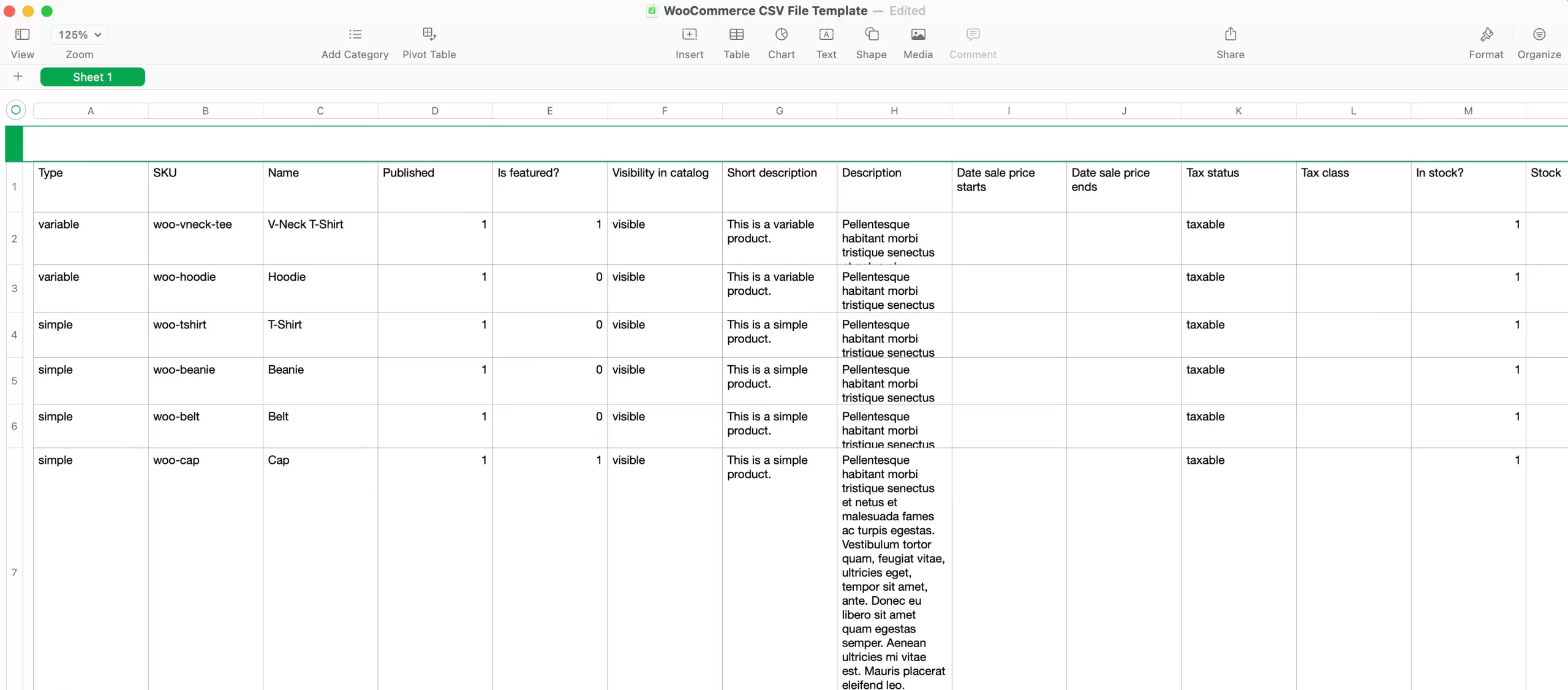
For how to add images when performing WooCommerce product import, you must first upload your image files to your WordPress WooCommerce dashboard.
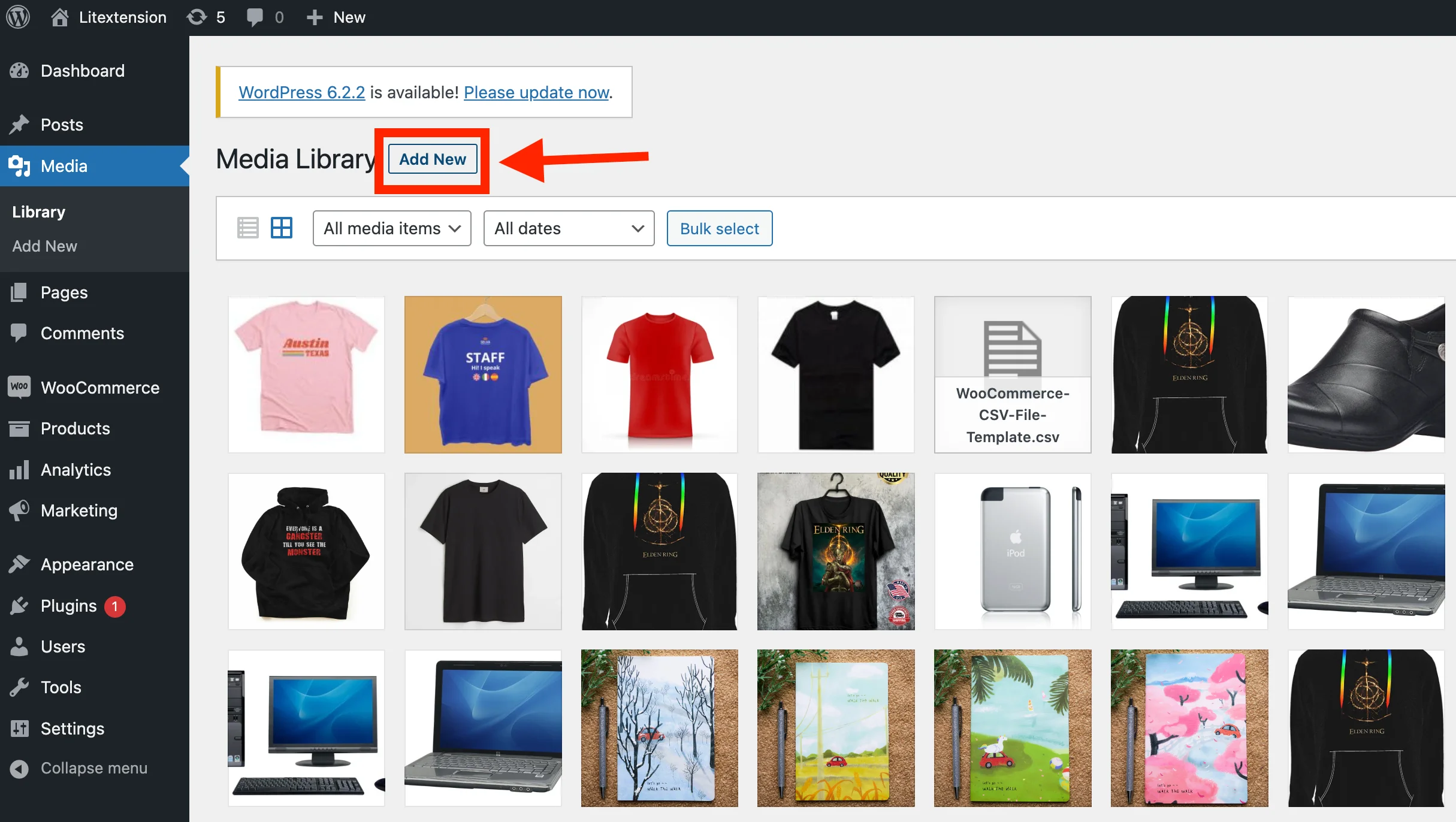
When you've uploaded the image file to WooCommerce, find the image URL:
Find image URL and fill it into your WooCommerce CSV file:

To be more specific, you can follow some basic instructions for managing data and images:
CSV Files | Product Images |
• CSVs should be in UTF-8 format. | • Images need to be pre-uploaded or available online to import to your store. |
Once you've finished customizing your file, export the file to CSV, and we can move to the next step!
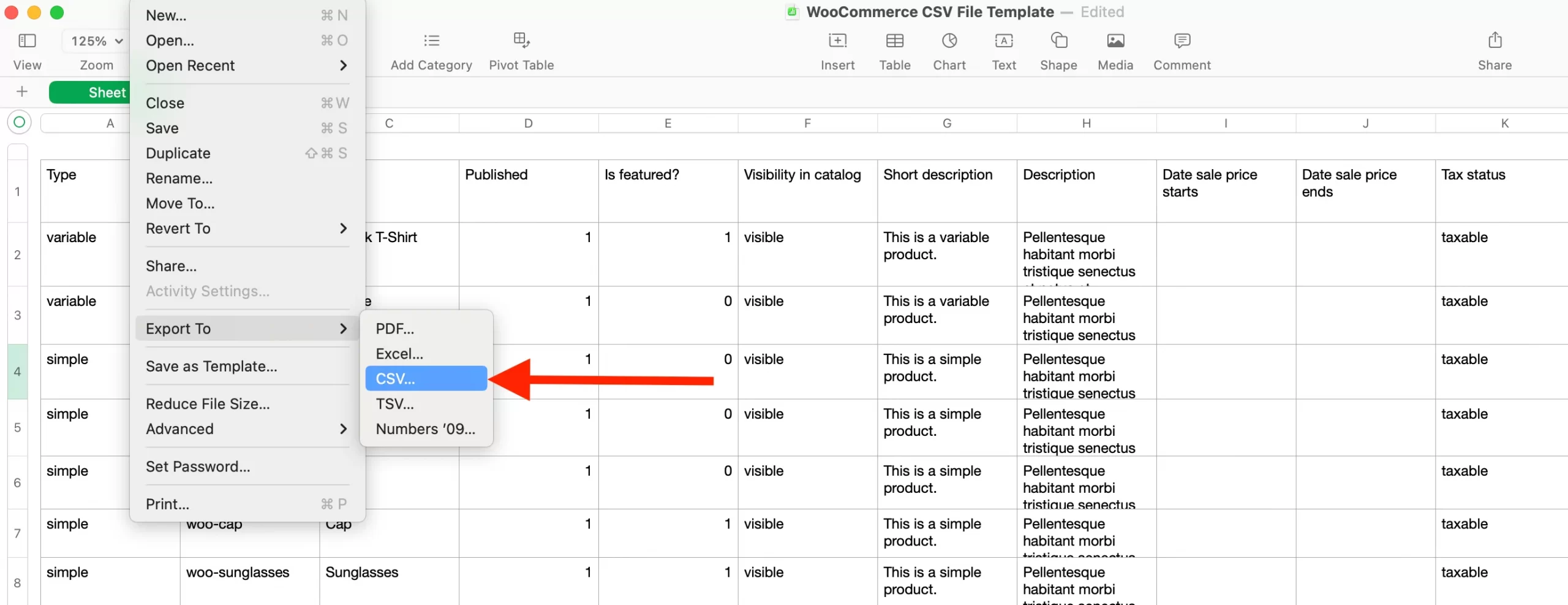
#3 Import CSV file to WooCommerce
From your WooCommerce Dashboard, select “Products” on the left-hand sidebar:

Next, click on “Import” and the system will redirect you to a page where you can upload the products via CSV file:
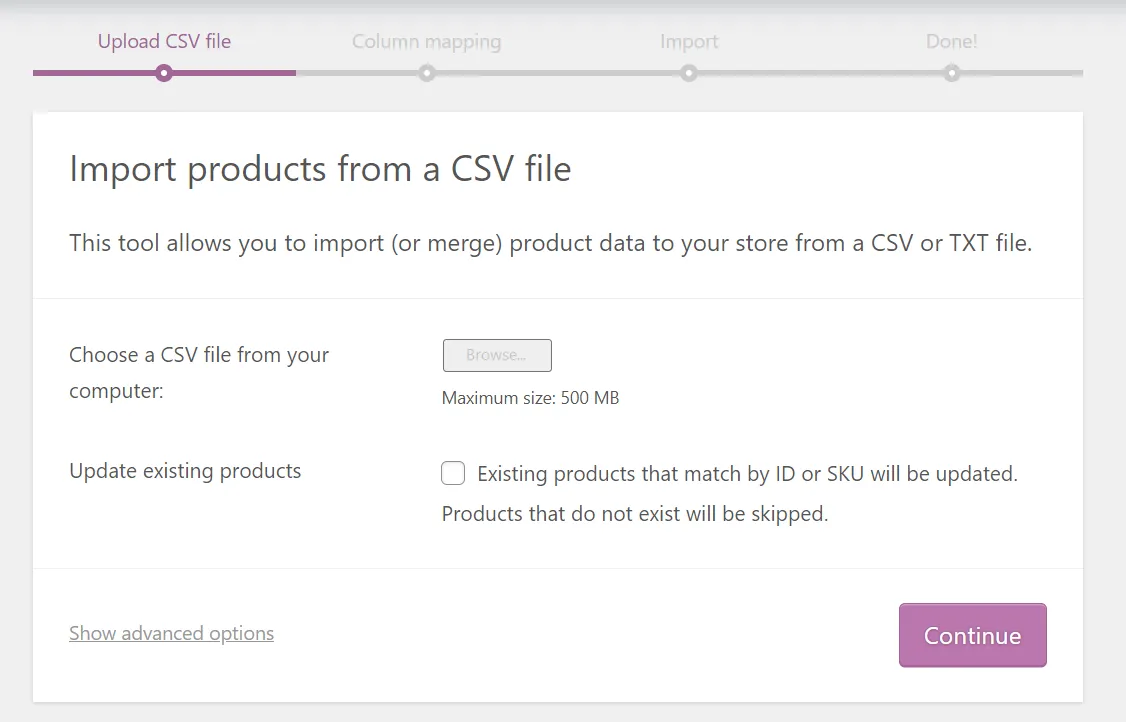
Hover your mouse over the “Choose file” button and “Continue” to go to the next step. For the Column Mapping, WooCommerce will automatically match the Column name on your CSV files to Fields:
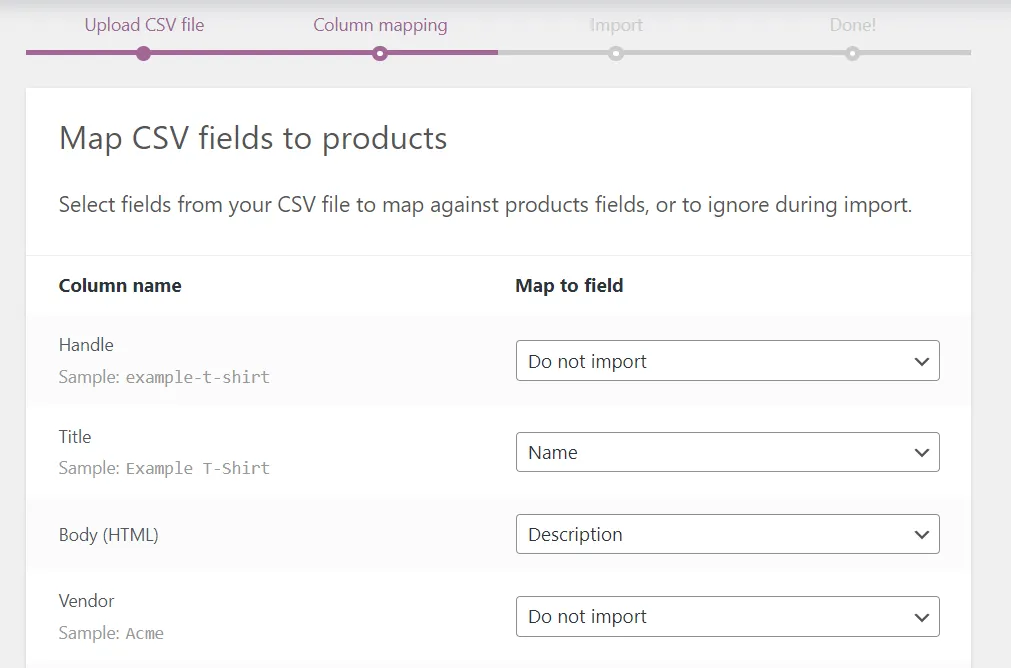
In addition, you can use the drop-down menus for advanced adjustments to the WooCommerce import categories. Complete the WooCommerce import CSV for products by selecting the “Run the importer” button:
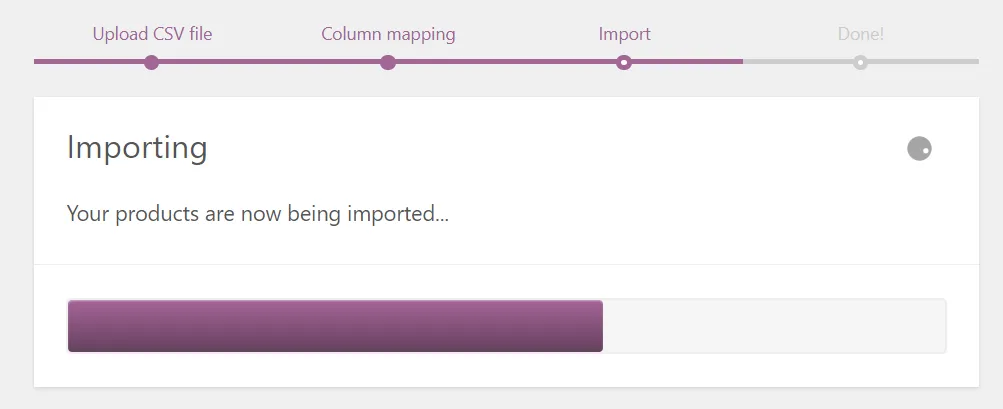
#4 Update existing products via CSV files
WooCommerce Product Importer CSV can also be utilized to update your existing product information, like adding a new brand, bulk-update, or changing tax class, etc. There’s not much difference in the steps for adding new products.
Likewise, starting with WooCommerce > Products > Import page. After uploading your CSV file, you tick the checkbox for “Update Existing Products” right under:
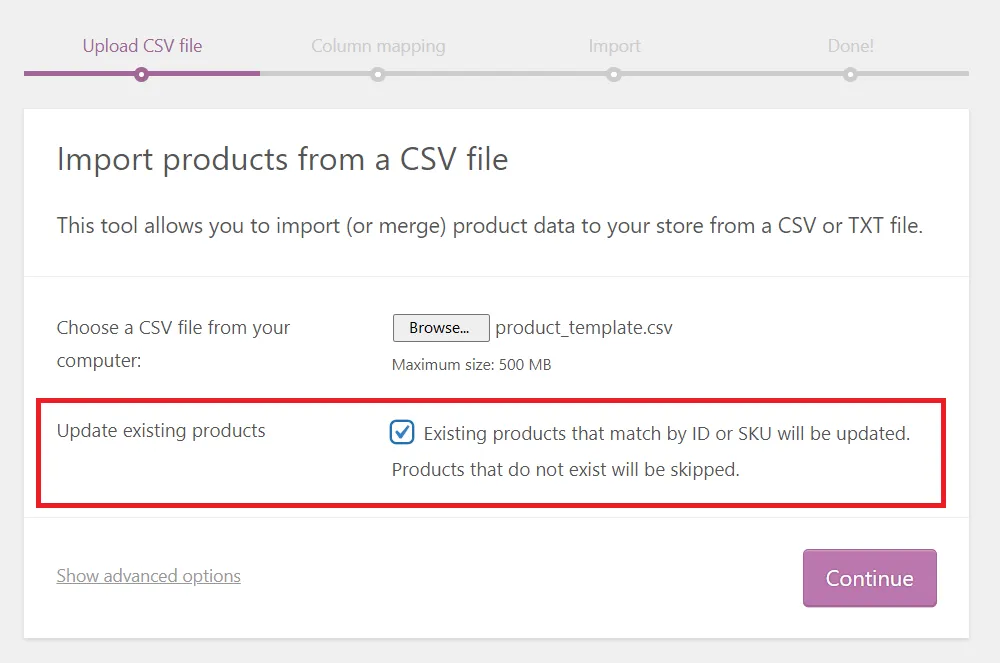
Click on “Continue” and the rest of the process will remain the same.
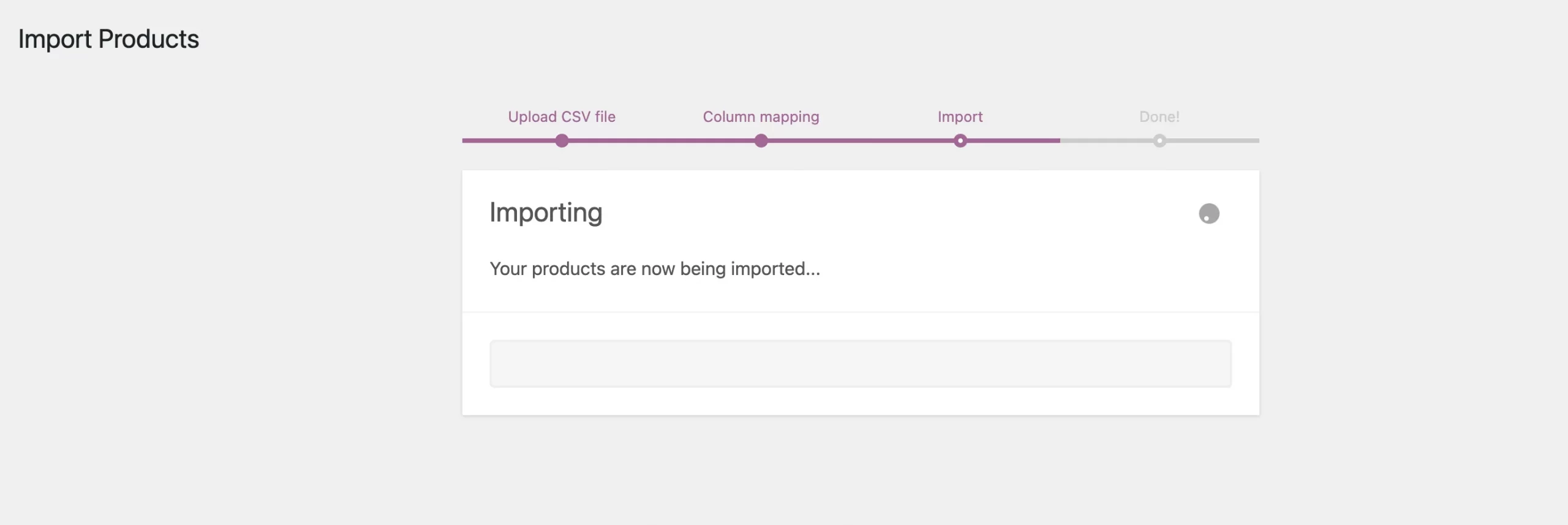
When the process is done, you will see a message showing on the screen below
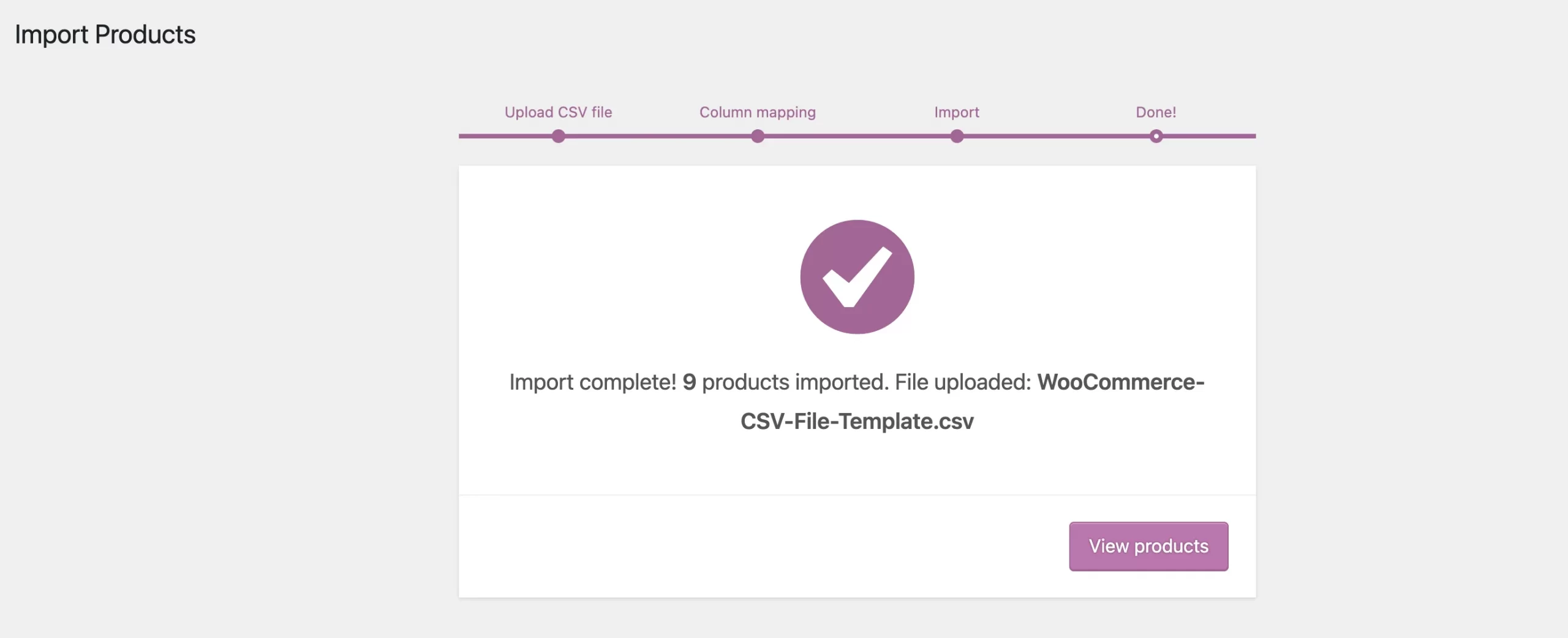
#5 Check final result in WooCommerce store
We're in the final steps of WooCommerce CSV import – check the final results on your WordPress WooCommerce store.
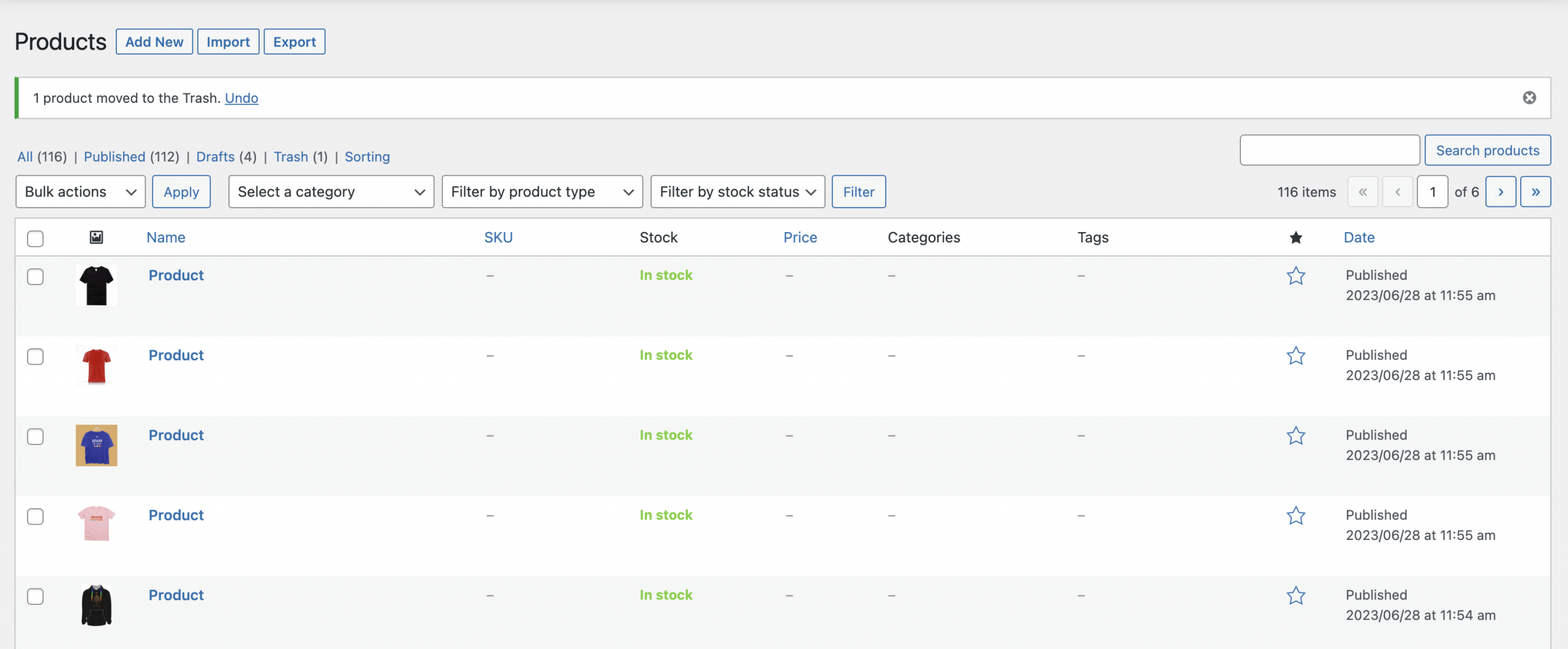
Take the time to thoroughly examine the imported data and verify that it is accurately reflected in your store. This step is crucial to guarantee a smooth data import and ensure that your products are accurately presented to your customers!
And that's how you perform WooCommerce CSV import manually!
How to Perform WooCommerce CSV Import with LitExtension?
How about a more simple method in which you can automatically import your CSV file to the WooCommerce store with no hassle?
When it comes to WooCommerce CSV import, LitExtension is here to guarantee a seamless CSV File Migration. You can eliminate the risks and complexities associated with manually handling this intricate task! Rather than attempting the challenging process yourself, we offer this service that minimizes the potential for errors and streamlines the entire WooCommerce CSV file.
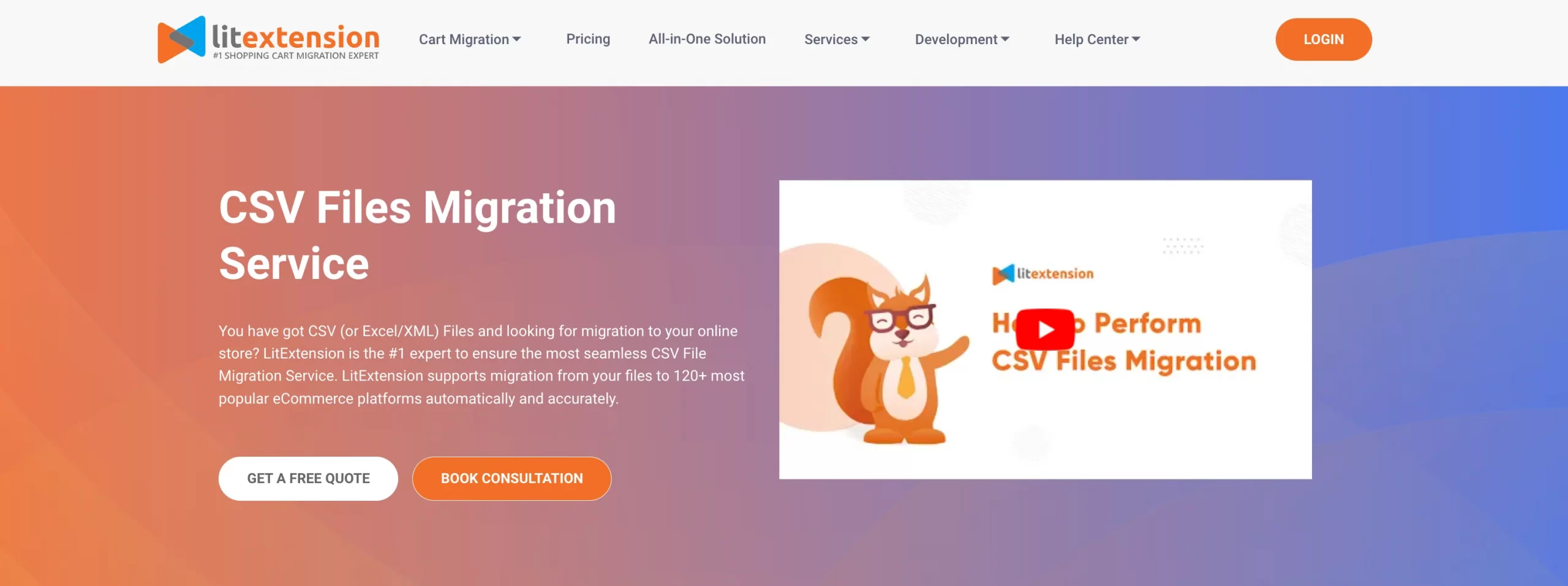
Here's how to LitExtension handles your WooCommerce CSV import:
#1 Receive your CSV files
LitExtension will receive your CSV files containing the necessary data for your store. Your files could include product information, categories, pricing details, and any other relevant data.
#2 Customize CSV files to your requirements
Once we receive your CSV files, our team will work closely with you to understand your specific requirements. We will customize the CSV files to ensure they align with your desired data structure, fields, and formatting. This step allows us to tailor the import process to match your unique needs before migrating data to WooCommerce.

#3 Run CSV files migration to WooCommerce
With the customized CSV files in hand, we will start the CSV file migration process. Here, we will create updated products, categories, attributes, and other relevant entities based on the provided CSV data you've sent us.
We will ensure that the data from your CSV files are accurately imported into your WooCommerce store!
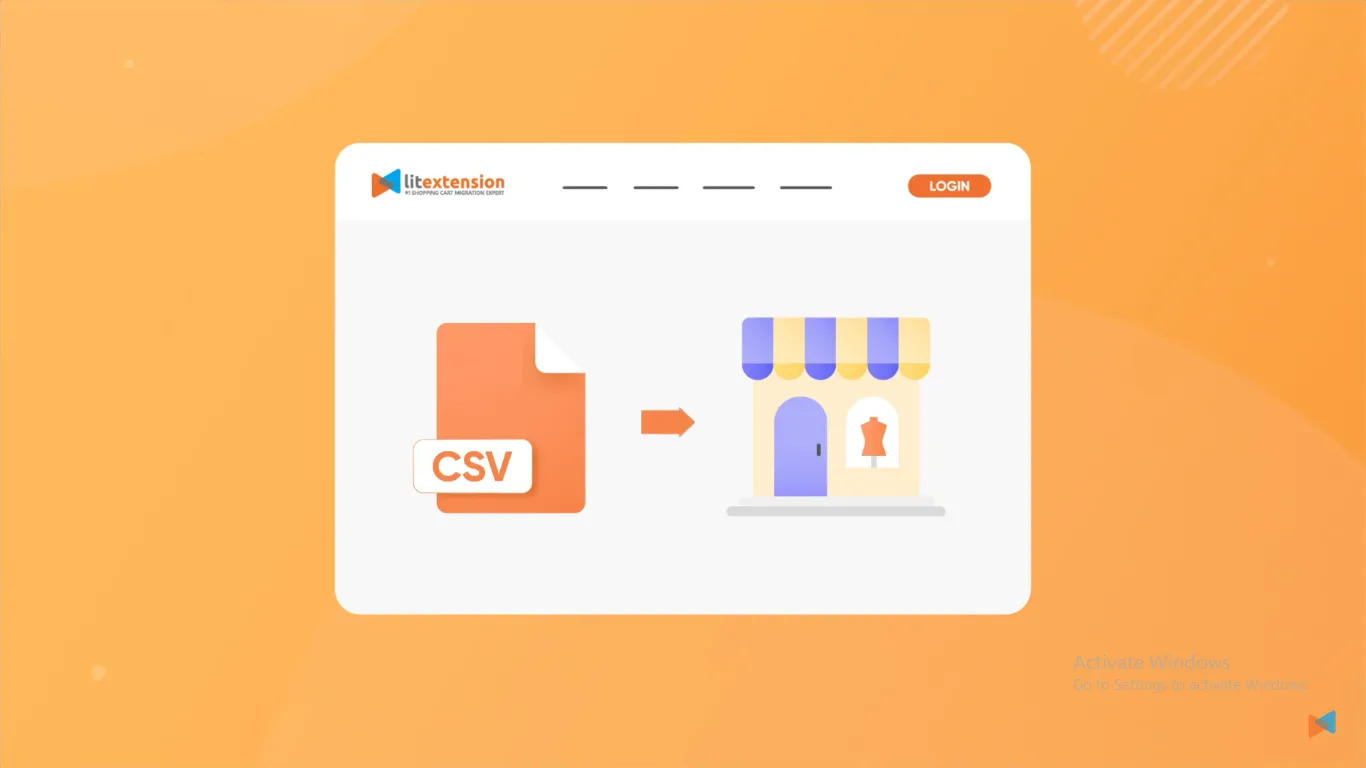
#4 Check migration result & Hand over store to you
Once the migration is complete, we meticulously review the results to ensure everything has been accurately transferred. Our team will examine that all data have been imported correctly. We will also address any issues that may arise during the migration process.
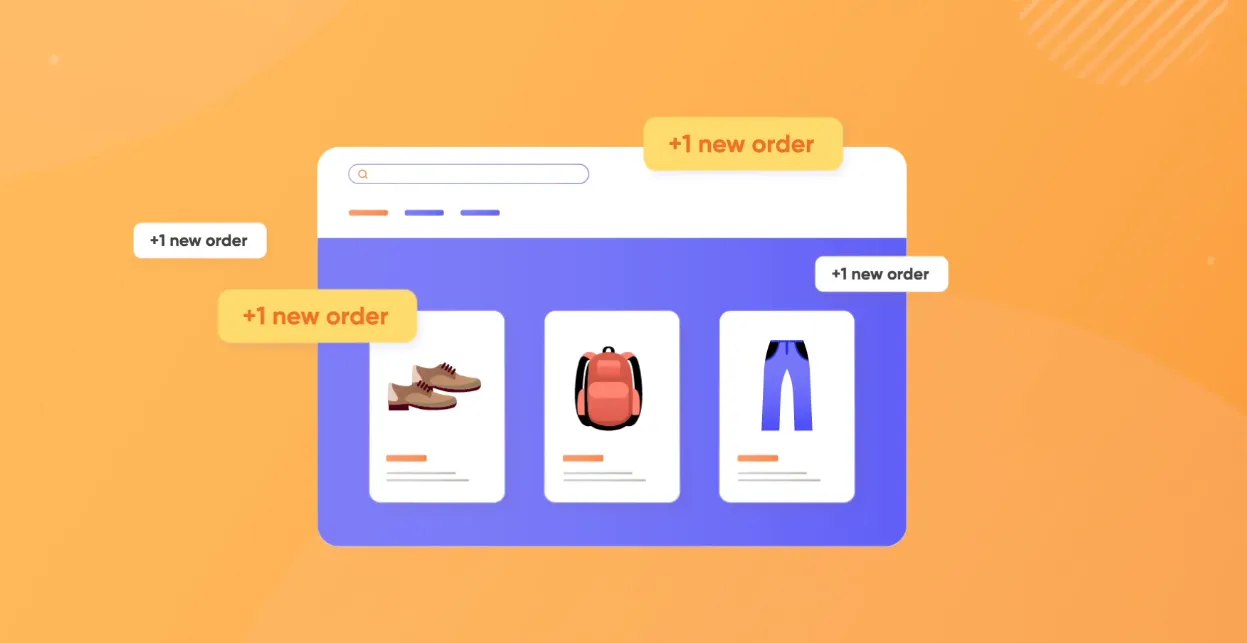
Once the review is complete, we will hand over the store to you, empowering you to take control and manage your WooCommerce store with the imported data. You can look further at how we perform CSV file migration in the below video!
With LitExtension, you can confidently avoid the hitches of manually managing the import and ensure a smooth and trouble-free transition to WooCommerce.
Need Help To Migrate to WooCommerce?
LitExtension provides a well-optimized All-in-One migration service for your data transfer.

Bonus: WooCommerce CSV Import with Plugins
Though they may not offer the same comprehensive solution as LitExtension, these WooCommerce CSV import plugins still have their respective strengths.
To save you hours of research, we’ve summarized the key features and drawbacks of each WooCommerce schema/plugin in the table below:
Plugin | Pros | Cons | Pricing |
WP All Import | - Supports all data types, including products | - Free version has limited features | Free version available; Pro starts at $99/year for unlimited installations |
Woo Import Export | - Handles images and variable products effectively | - Lacks an embedded function editor for data transformation | Pro version starts at $229 for a single site license |
Product Importer Deluxe | - Some support for image and variable product imports | - Limited support for serialized fields | Pro version starts at $79/year for a single site license |
Product Import Export for WooCommerce | - Allows mapping data to product attributes | - Inability to handle complex data formats | Free version available; Pro starts at $69/year for a single site license |
WooCommerce Product CSV Import Suite | - Simple and cost-effective for controlled data sources | - Poor handling of CSV formatting issues | Pro version costs $59/year |
WooCommerce CSV Import – FAQs
How do I import a CSV file into WooCommerce?
To manually import a CSV file into WooCommerce, follow these steps:
- On the WordPress WooCommerce admin dashboard, navigate to Products.
- Select Import.
- Choose a CSV file from your computer by clicking Choose File > hit Continue.
- Map your data field as you see Do not import
- Hit Run the importer.
- Wait for your WooCommerce import products CSV successfully!
Why is my CSV file not importing?
WooCommerce CSV import not working normally happens when any conflict arises with your theme or another plugin or your CSV is too large.
Our solution for these cases is to:
- temporarily disable all plugins except for WooCommerce.
- delete unnecessary data filed on CSV files.
How do I import categories from CSV to WooCommerce?
Currently, WooCommerce does not support importing categories directly to this platform. So, you may need to install a plugin that supports you through the process.
However, if you choose LitExtention for your WooCommerce import categories, everything becomes much easier. You can not only perform import categories WooCommerce, but you can also transfer other data like Customers and Orders to this platform!
How do I manually add a product to WooCommerce?
To add a product to WooCommerce, online merchants can either upload a CSV file following the above steps or manually add one by one. To begin with, navigate to the Products > Add New from your dashboard.
Here, fill in the required information about your products so that customers can best understand them and make purchase decisions. These include titles, descriptions, product images, SKUs, weights, dimensions, and so on.
After you have finished, click the “Publish” button to make your products visible to the visitors.
Is WooCommerce no longer free?
Up to the present, WooCommerce is still an open-source cart and free for everyone to use and download. Still, to maximize your website’s performance, we strongly recommend to add several extensions for more advanced features.
How do I import perform WooCommerce Excel import?
You can choose to use the built-in Product CSV Importer and Exporter because WooCommerce only supports CSV or TXT file types with direct import.
Thus, if you want to import an Excel file, you will need to ask for help from a WooCommerce product import plugin. In this case, we tried out WP All Import plugin, which allows users to match the fields via Excel file effortlessly.
Final Words
And that brings us to the end of our guide on how to perform WooCommerce CSV import data.
To put it briefly, there are multiple ways you can apply when it comes to product importer WooCommerce as long as it brings back the best suitability. Hopefully, our guide today on How to perform WooCommerce import has successfully helped you to perform the process with ease and generate more profits in the long run.
If you have any related questions, LitExtension – #1 The World Shopping Cart Migration Expert is always here to help. For more insights about WooCommerce, don't forget to check out other related articles in our blogs.
